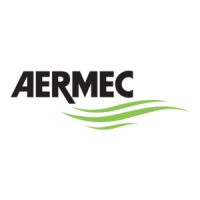REFRIGERANT CHARGE
These procedures must only be carried out by
specialised technicians or qualified personnel.
• Make sure no other type of refrigerant can
contaminate the refrigerant gas.
• The gas cylinder must be kept in a vertical position
during charging.
• Attach the relative label to the unit after charging.
• Do not charge more refrigerant gas than necessary.
• After charging, carry out the leakage detection
operations before testing unit operation.
• A second gas leak check must be made when all the
previous operations have been completed.
QUALIFICATION REQUISITES FOR INSTALLATION
AND MAINTENANCE
• All operators working with the cooling circuit must
have obtained the certificate to be able to work
with these gases. This certificate is issued by the
organisation in authority, and must be recognised
by the company or agency where these operations
are carried out. Otherwise, the operating technician
must be watched by a third party who possesses this
certification.
• The unit must be installed in a room of the minimum
permitted dimensions.
• Maintenance operations must be carried out in a
room of the minimum permitted dimensions.
• Make sure the maintenance area is well ventilated.
The ventilation status must be maintained for the
entire duration of the operation.
• The unit must only be repaired using the method
indicated by the manufacturer.
SAFETY STANDARDS FOR THE TRANSPORTATION
AND STORAGE OF R290 GAS
• Using a suitable gas detector, check there are no
gas leaks in the room before opening the unit
packaging.
• Make sure there are no ignition sources near the
unit.
• It is forbidden to smoke near the unit.
• Transportation and storage must comply with the
national regulations in force.
SAFETY STANDARDS FOR REFRIGERANT DISPOSAL
AND RECOVERY
These procedures must only be carried out by
specialised technicians or qualified personnel.
DISPOSAL:
• To recycle the refrigerant, analyse the refrigerant and
oil samples beforehand. Guarantee the power level
required before the test.
• Disconnect the power supply.
• Make sure all the PPE (personal protective
equipment) complies with the regulations in force.
• Make sure all the devices used to remove the
refrigerant comply with the regulations in force.
• Extract the refrigerant from the circuit. If it is not
possible to extract from a single point, use other
extraction points to fully bleed the system.
• Before carrying out these procedures, make sure the
containment tank is big enough.
• Only fill the tank to 80% of its capacity.
• Do not exceed the maximum pressure permitted by
the tank, even if the work time is limited.
• After completing the discharge procedure, quickly
close the valves and remove the equipment used.
• Make sure the refrigerant has been cleaned before
being used on other systems.
• The recovered refrigerant must be labelled to
identify it once the unit has been drained. The
identification of the refrigerant must include the
date and approval. Check there is a warning on the
unit showing that it contains flammable refrigerant.
RECOVERY:
• You are advised to discharge the refrigerant
completely.
• Before doing this, make sure the containment tank is
big enough for the system, and carries the necessary
warning signs. In addition, the tank must be fitted
with a drain valve and a ball valve (kept in good
condition). Before being used, the tank must be
empty and at room temperature.
• The equipment must be kept in good condition and
must carry user instructions. It must be certified
as suitable for the recovery of R290 refrigerants.
The pipe must be connected with a removable
connection joint that guarantees a zero loss rate, and
must be kept in good condition. Before using the
equipment, make sure it is in good condition and
that maintenance has been carried out perfectly.
Check the electrical components are sealed to avoid
any refrigerant leakage that may cause a fire. If you
have any questions, contact the manufacturer.
• The recovered refrigerant must be loaded in
the relative storage tanks, accompanied by
transportation instructions and returned to the
manufacturer. Do not mix the refrigerant in the
recovery equipment, especially in a storage tank.
5

